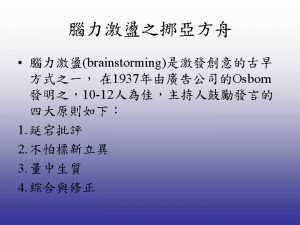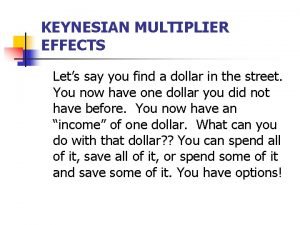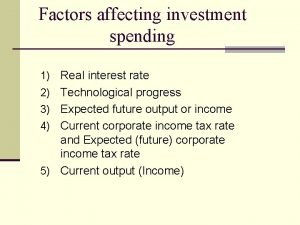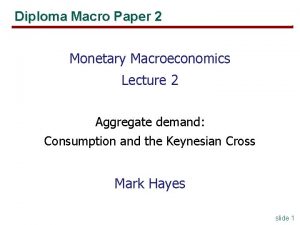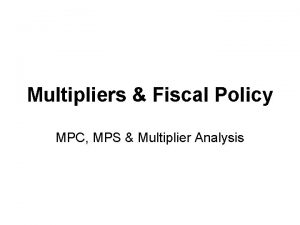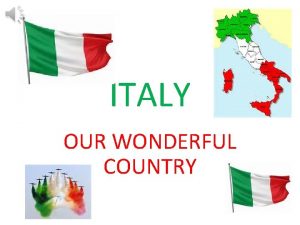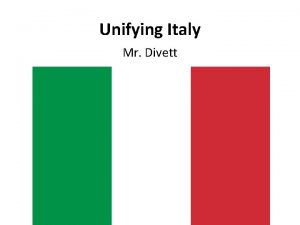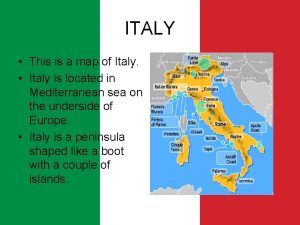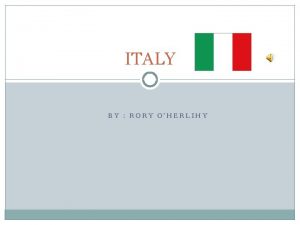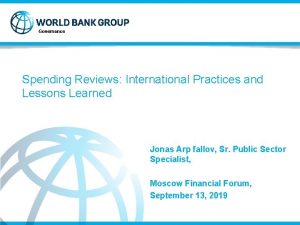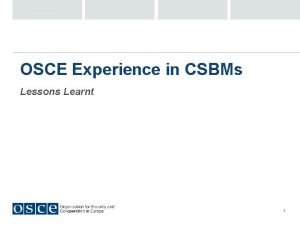Spending reviews in Italy Lessons learnt from experience



















- Slides: 19

Spending reviews in Italy Lessons learnt from experience Aline Pennisi Ministero dell’economia e delle finanze

WHAT IS A SPENDING REVIEW (SR) ? § Unlike other processes aimed at using systematic analysis of expenditure in financial planning (e. g. , zero-based budgeting, performance budgeting), SRs is not a “technique”, it can include flexible features and use different tools at the same time: o o efficiency analysis evaluation of public policies systematic reviews of expenditure or individual programmes revision of the perimeter of public intervention, etc. § Spending reviews or spending cuts ? The main goal of SRs change over time, even within the same country. The financial crisis teaches that context can drastically change SR objectives and strongly influence the process § There are many definitions of spending review, and the role played by the institutional actors also vary across countries and over time. A sign of a wellfunctioning spending review process is perhaps that it is continuously tailored to provide an answer to current challenges. » (Hawkesworth e Klepsvik, 2013)

CONTEXT FACTORS IN DETERMINING SR GOALS AND PROCESS The following contexts are relevant in shaping the goals and process of a SR : • The economic context - in "good" and "bad times" SRs can have different objectives: expenditure prioritization, finding fiscal space, improving quality of services, consolidating quickly…. • The institutional context - national institutional structure may determine who governs the SR (PCM, Mo. F, others) and the relationship between different actors (including Parliament); supranational institutional structures may condition the size and dynamics of the expenditure and the objectives of the SR • The electoral cycle – it can favors strategic SRs for example when there is a change of Government, but it can also influence the type of SR measures and time afforded to implement them (gaining efficiency in some services might require investment expenditure first…)

POSSIBLE COMBINATIONS THAT SHAPE SRs Six main dimensions can be referred to classify spending reviews (Kraan, 2007; OECD, 2011; Hawkesworth e Klepsvik, 2013; Robinson, 2014): 1) The perimeter of the analysis (type of expenditure or program or department; strategic or efficiency) 2) The time scope and frequency 3) The ex-ante setting of a saving’s target or expenditure ceilings 4) The responsibilities of the various institutional actors (who coordinates? What is the role of the Parliament? ) 5) The participation of external experts (opportunities and challenges) 6) The use of public consultations (legitimacy and cooperation)

THE TECHNICAL PUBLIC FINANCE COMMISSION (2007 -2008) In Italy, the first “official” SR program was established by the 2007 Budget Law on an “extraordinary” basis and with the following features: • The Ministry of economy and finance (MEF) was mandated to carry out a systematic review of central government spending programs • In cooperation with a special Technical Public Finance Commission (Commissione Tecnica per la Finanza Pubblica, CTFP), made by external experts • Five Ministries were part of the analysis: Transport, Infrastructure, Justice, Domestic Affairs and Education • CTFP adopted a “productivity/organizational” approach, concentrating on international comparisons, efficiency of territorial branches, career qualifications of employees, overcoming weak monitoring and scarce evaluation of public policies

THE MEF AND LINE MINISTRY SPENDING TEAMS (2010 -2013) In 2008 the CTFP was relieved of its duties, but the SR program was made “permanent” : • • The new Public Accounting and Finance Law (Law 196/2009) provided a general framework to introduce the SR in the ordinary budget process and extend the “SR method” to all public administrations These first SRs were carried out in cooperation between the Ministry for economy and finance and line Ministries by a “team” of representatives of each side, with a wide mandate. Their work focused mainly on: o o • specific sectoral analysis, for example on the efficiency of territorial branches of Ministries proposals of indicators to monitor policy “impacts” and to be adopted in performance-budgeting exercises The MEF started producing a number of documents, statistics and open data directed towards the general public (and to the Parliament), but the “teams” had weak political mandate

THE SR COMMISSIONERS (2011 -2017) Under the pressure of the economic and financial crisis, subsequent Governments decided to give SRs a stronger role and special mandates were given to “Commissioners” designated by the Council of Ministers (with a shift in coordination from MEF to PCM): • The first Commissioner had a specific mandate on reducing expenditure for goods and services and cuts were performed to bring all administrations to the median expenditure of standard categories of goods and services • The following Commissioners had an extended mandate and focused on all types of expenditures and also on reorganizing publically-owned private companies • The second Commissioner presented a structured working plan and established many working groups on specific topics and with line Ministries (see. http: //revisionedellaspesa. gov. it) and external experts. Some measures were taken in legislation, especially as concerns the new public procurement strategy. • The third Commissioner focused on making the new public procurement strategy work, especially in the health sector, and reorganizing the police forces. 7

THERE HAVE BEEN SOME RESULTS …. Primary current expenditure trend. Number index 1999=100 (nominal values) 190 180 170 160 150 140 Primary Current expenditure Final consumption expenditure of general government in % GDP 130 120 110 Primary Current expenditure (net social benefits) 1999 2000 2001 2002 2003 2004 2005 2006 2007 2008 2009 2010 2011 2012 2013 2014 2015 2016 2017 2018 2019 2020 2021 2022 100 Source: 2010 -2018, Istat (general government accounts) 2019 -2022, MEF trend forecast Source: Ameco data

… BUT ALSO SOME PITFALS The SR initiatives in Italy were mostly developed on an ad hoc basis. Results have been mixed and difficult to evaluate because of overlapping initiatives and pressure coming from fiscal consolidation needs. • • A SR approach was often conducted at the same time across-the-board cuts were also being performed. Across-the-board cuts have been useful to intervene quickly but in most case they were not structural, generated distorted expectations and window-dressing and did not ensure efficiency improvements and/or produced undesirable effects (e. g. , off-balance sheet debts). When saving measures were devised with the direct involvement of line Ministries, they were more effective in the medium-term Lack of monitoring and evaluation culture did not always help building robust SRs SR proposals were not necessarily available at the “right time” to be used Political instability did not always support conducting the SRs “Separate rooms” to discuss saving options, baseline projections and new expenditure proposals did not favor commitment to the SR This led to the view that SRs where better placed in a structured, regular and multiannual process, such as the budget cycle.

THE SR IN THE BUDGET REFORM Italy’s recent organic budget reform introduced some features of topdown programming which has favored, among others, a link between the SRs and the budget cycle: • budgetary planning is now oriented to the medium term, with effective three-year planning of policies, objectives and resources • there more focus on overall allocation of resources with the new budget law (instead of focus on marginal adjustments of the previous Stability law) • policies are more visible in the budget thanks to mission/program structure • Government announces the aggregate fiscal target broken-down by subsectors in the Economy and Finance Document (EFD) and then line Ministries are assigned three-year “spending targets” (in practice saving targets or expenditure ceilings) • their budget proposals must reach the “spending targets” • the achievement of the targets should be monitored during the year under specific “agreements” between the Mo. F and each line Ministry, from both a financial and results-based approach (and published on MEF website) • An annual monitoring report is annexed to the Economy and Finance Document (EFD) of the following year (the EFD undergoes Parliament resolution)

THE SPENDING REVIEW INTEGRATED IN THE BUDGET CYCLE February/ March Results of monitoring the last three-year agreements for each administration Report on SR deviations to Council of Ministers April / May EDF (10 April) with macroeconomic framework and general govnt expenditure rule (UE benchmark) Decree of the PM setting government priorities and three year spending targets for each Ministry June / August Definition of the proposals on how to meet the spending targets through: • Efficiency improvement through administrative action September EDF Update (27 September) Mo. F coordination of the proposals and check of macroeconomic framework • Legislative proposals Budget preparation Circular Monitoring of three-year agreements October/ January the budget bill (integrated with Stability law) contains the legislative proposals following the approval of the Budget Law, the signature of three-year agreements (1 March)

THE SPENDING REVIEW INTEGRATED IN THE BUDGET CYCLE public finance objectives and budget preparation EFD and Update to the DEF (10 th April) - (20 th September) 10 th April: it sets out the public finance and economic strategies for the mid-term, with subsector targets 20 th September: It updates the public finance and economic forecasts, and provides budget guidelines top-down approach based subsector targets reported on the draft budgetary plan, specific targets are assigned to each Ministry (in terms of reductions or budget ceilings) Draft budget law (including performance document) + Stability law (15° - 20 th October) budget execution budget reporting State Budget Law General State budget Final Accounts (update to performance document , three-year agreement) 31 st December The budget proposal (including the financial corrective measures) take into consideration the result of the agreement monitoring three-year agreements between line Ministries and MEF arrangements for pursuing the assigned targets and monitoring them Expenditure monitoring and evaluation MEF in collaboration with line Ministries (Performance results document) 30 th June

ASSIGNING SPENDING REVIEW TARGETS Since the 2018 -2020 budget cycle, saving targets are assigned to each Ministry (more or less “formally”). They are calculated on the basis of the composition of expenditure of each Ministry net of: Ø Ø Ø interest; items which have no effect on net borrowing (e. g. tax adjustments and reimbursements, acquisitions of financial assets and depreciation); transfers to other sectors of the public administration, which are governed by rules and instruments outside each Ministry’s reach (e. g. transfers to health, municipalities, social security institutions and constitutional bodies, …); reserve funds; personnel expenditure is included in the quantifications, but only at a 5 per cent rate In some cases the Government has also set political priorities, blocking savings on selected policy areas (e. g. , infrastructure spending, earthquake reconstruction, fight against poverty and migration were excluded from the 2018 SR)

SNAPSHOT OF THE 2018 SR Ministries were assigned saving targets and guidelines were provided on the type of proposal and documentation needed for technical and political assessment. Saving measures could relate to: • revision of administrative or organizational procedures/processes • de-financing already envisaged projects with less priority or effectiveness • reform of mechanisms or parameters regulating the evolution of expenditure, determined by law 14

SAVING MEASURES ADOPTED IN THE 2018 SR Saving measures ranged across nearly all 34 missions of the budget and ranged from a few hundred Meuro to a few thousand euro, skewed to the lower end of the distribution. Examples: reform of laws: • • abolition of a tax incentive on petrol and diesel in northern border areas (5 million euros of savings) reduction of the rate of social security tax break for fishing enterprises (2 million euros) efficiency cuts: • • • savings on compensation for delayed relief for overpaid taxes thanks to new organization of bureaucratic procedures (300 million euros) reduction of the number of new auxiliary judges to hire for the Appeal Court (1 million euros) introduction of a voucher based system instead of the canteen services in remote areas for the State Police (3 million euros) gradual reduction of heating expenditure, thanks to renovation of buildings gradual reduction of rent expenditure, through transfer to publically owned buildings and space saving measures (8. 9 million euros) use of video conferencing systems for remote participation in trials to reduce expenditure in transporting detainees (2. 9 million euro) de-financing of less priority programs: • ending of extra state funds for municipal dog shelters (310 thousand euro) 15

MONITORING THE SR RESULTS The agreements between MEF and line Ministries detailed the data that was to be provided at mid and end-of-year to identify savings at risk and non-achieving measures, the obstacles encountered and possible remedial action. • A mid-term report was prepared in early July 2018 and presented to the Council of Ministers (…much later). The end of year report was annex to the EFD in April 2019 and there was a hearing in Parliament. • At end of 2018, most line Ministries managed to achieve their saving target, although in some cases they had to temporarily find additional funds (within their own budget) to cover for implementation delays or wrong forecasting • Overall 26 measures of the 162 either failed to reach their saving target or were repealed in the 2019 Budget Law (mostly on the basis of priorities decided by a new Government) 16

WHERE SRs FIT IN THE CURRENT SETTING q for central government (Ministries): setting saving targets for the budget programming process and monitoring their achievement q for Regions (which basically means the Health sector): the articulation between central government’s steering role and regional government’s delivery role is expressed in the Health Pact (a three-year plan). A consolidated mechanism of service quality indicators and standard cost parameters are applied and regional deficits are strictly monitored with sanctions applied q for Municipalities: estimation of standard expenditure needs (for each type of service) and standard fiscal capacity, through econometric estimation techniques. The exercise is used to increase expenditure efficiency at local level and to determine the way the national equalization fund should be distributed to municipalities to finance essential services (about 30 billion euros) q for all levels of government: strengthening and centralizing the public procurement system

A SR TOOL FOR MUNICIPALITIES Since 2009 (so-called “fiscal federalism” reform) discretionary grants from central to local governments were substituted by own taxes, surcharges and shared taxes assigned to Regions and Municipalities. The assignment of central resources across jurisdictions is based on the evaluation of standard indicators of expenditure needs and standard fiscal capacity for each local authority. In summary, there is an equalization transfer system to fill gap between standard expenditure needs and standard tax capacity for main municipal services. Data collection and analysis is performed by a company owned by the Ministry of finance and Bank of Italy SOSE Access to the updated data on 12 essential municipal services through the website www. opencivitas. it which provides a summary view, a comparison between the actual expenditure and the standard expenditure needs for each local administration, performance of services, indicators which are relevant to understand managerial and organizational choices of the local administrations.

 Early experience vs later experience debate
Early experience vs later experience debate Indirect experience
Indirect experience Imprinting psychology
Imprinting psychology How does bagchi define his father's success
How does bagchi define his father's success What have we learnt from the story
What have we learnt from the story A gift of chappals introduction
A gift of chappals introduction What have you learnt from the story
What have you learnt from the story L have just learnt to
L have just learnt to What have we learnt from the story?
What have we learnt from the story? What have you learnt from the story
What have you learnt from the story What have we learnt from the story? *
What have we learnt from the story? * Government expenditure formula
Government expenditure formula Deficit spending
Deficit spending Csi enterprises inc
Csi enterprises inc Factors affecting investment spending
Factors affecting investment spending Ap gov final review
Ap gov final review Spending plan shake up
Spending plan shake up Government spending multiplier
Government spending multiplier How to calculate mpc
How to calculate mpc Mental health spending
Mental health spending








